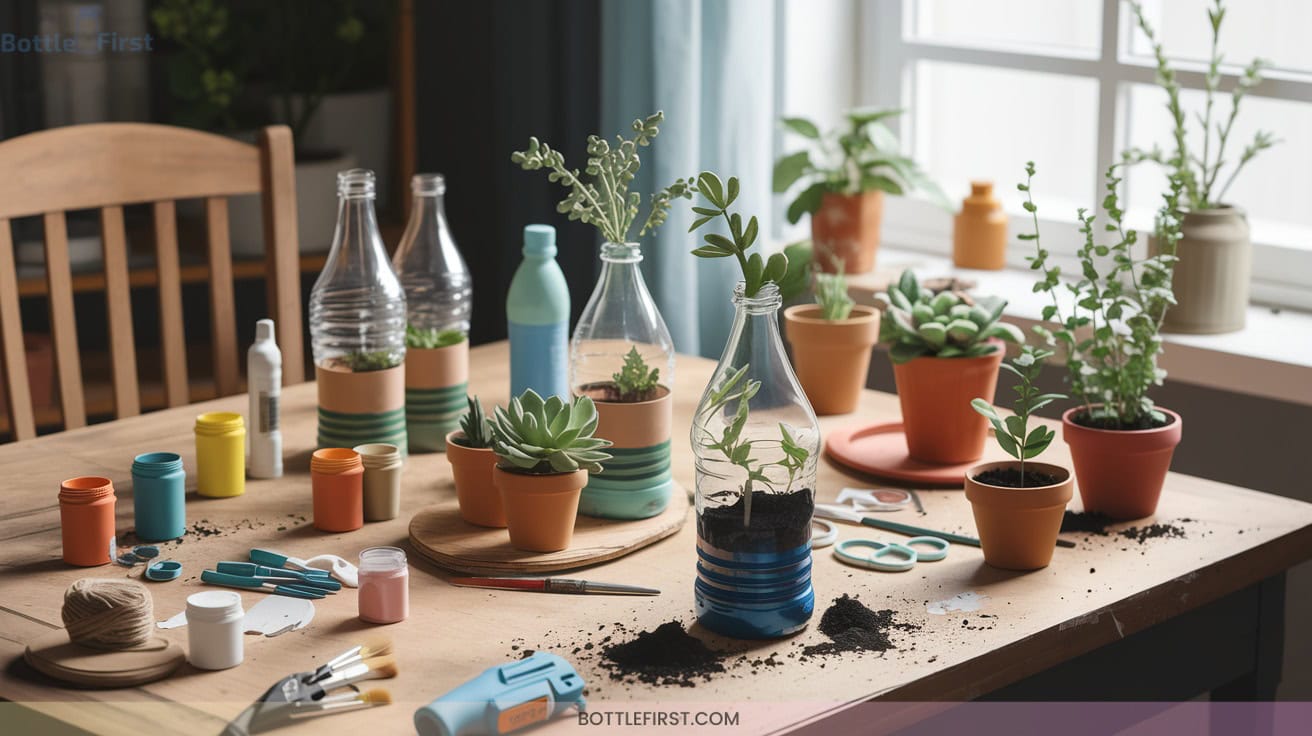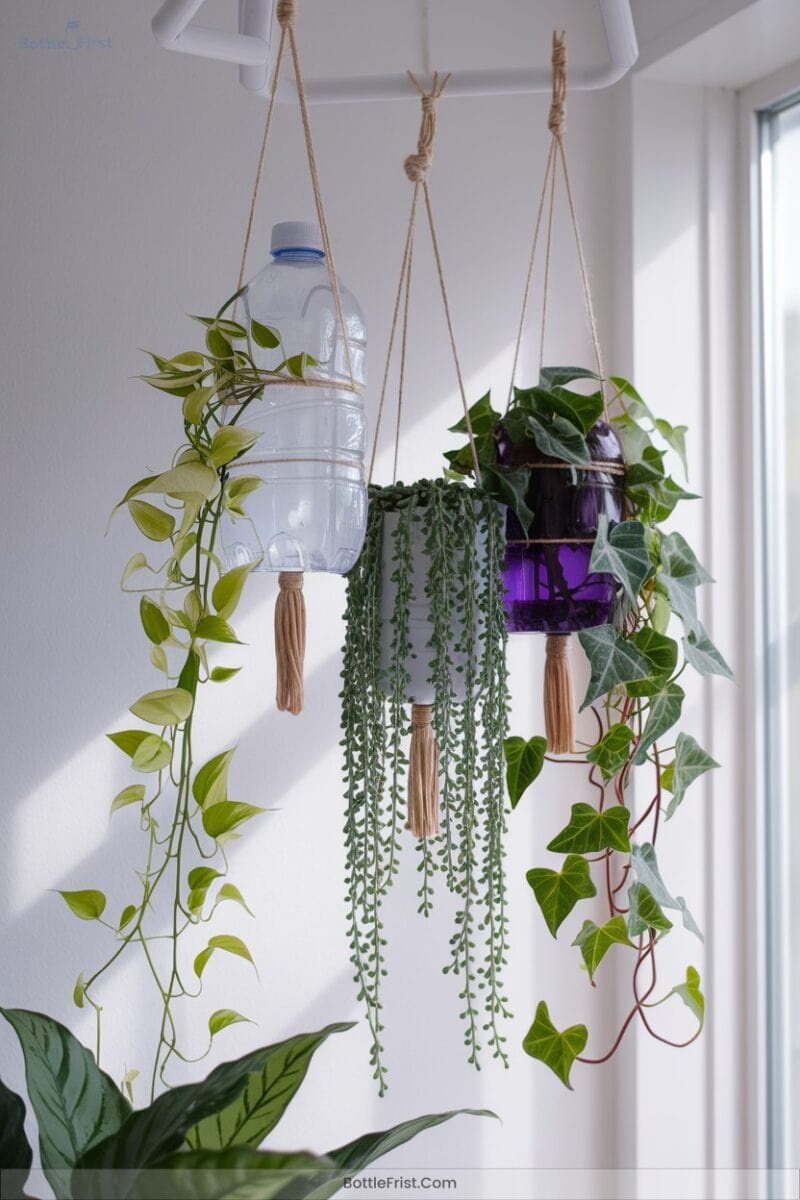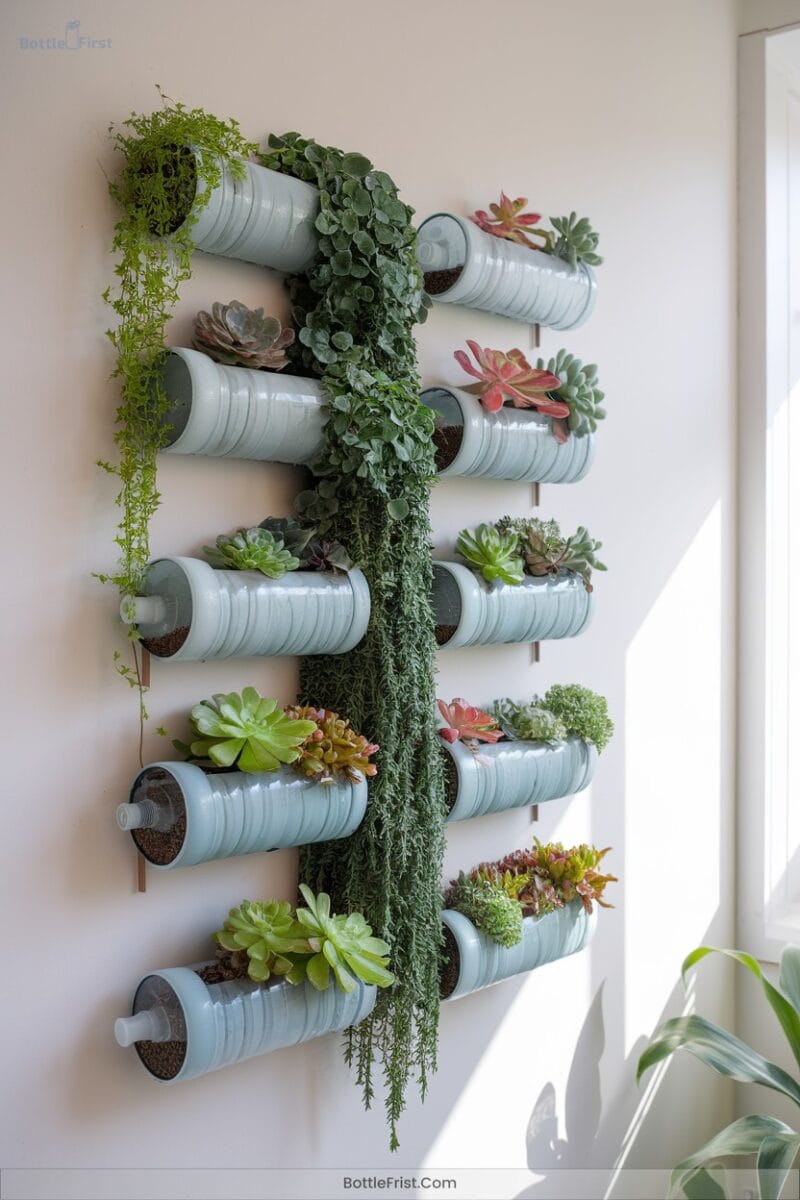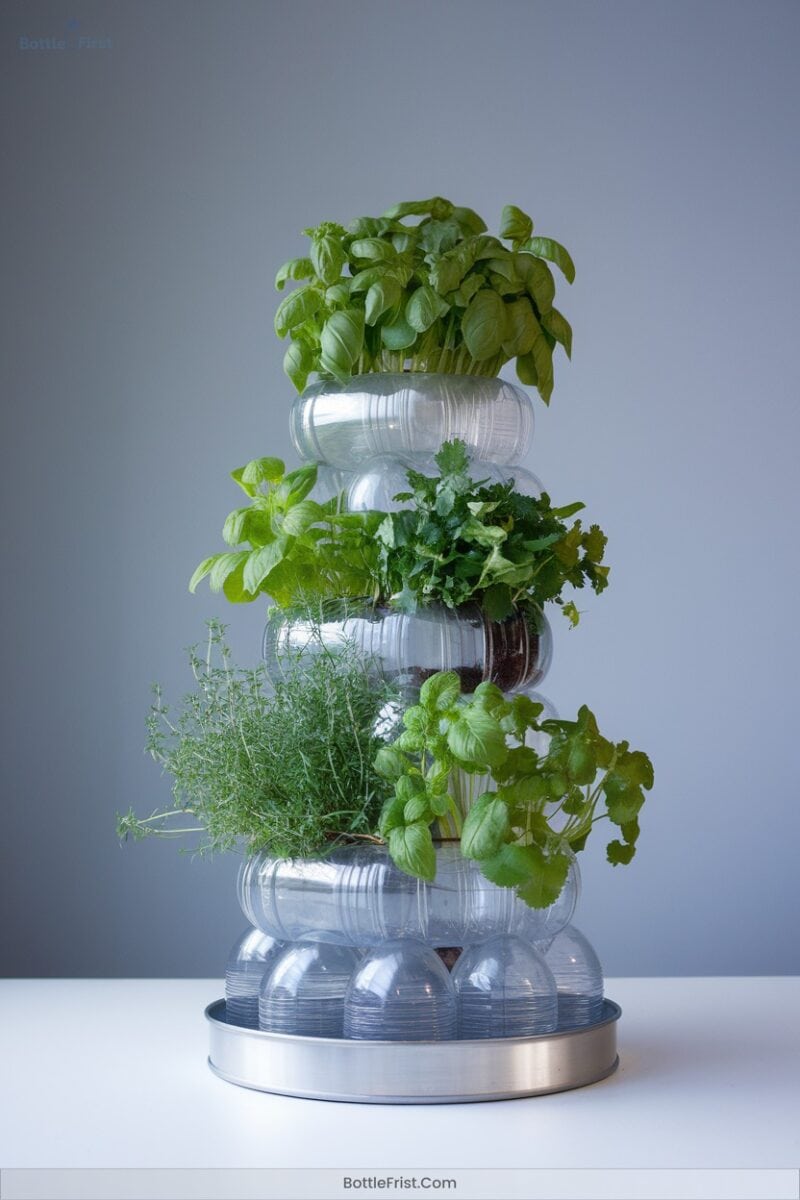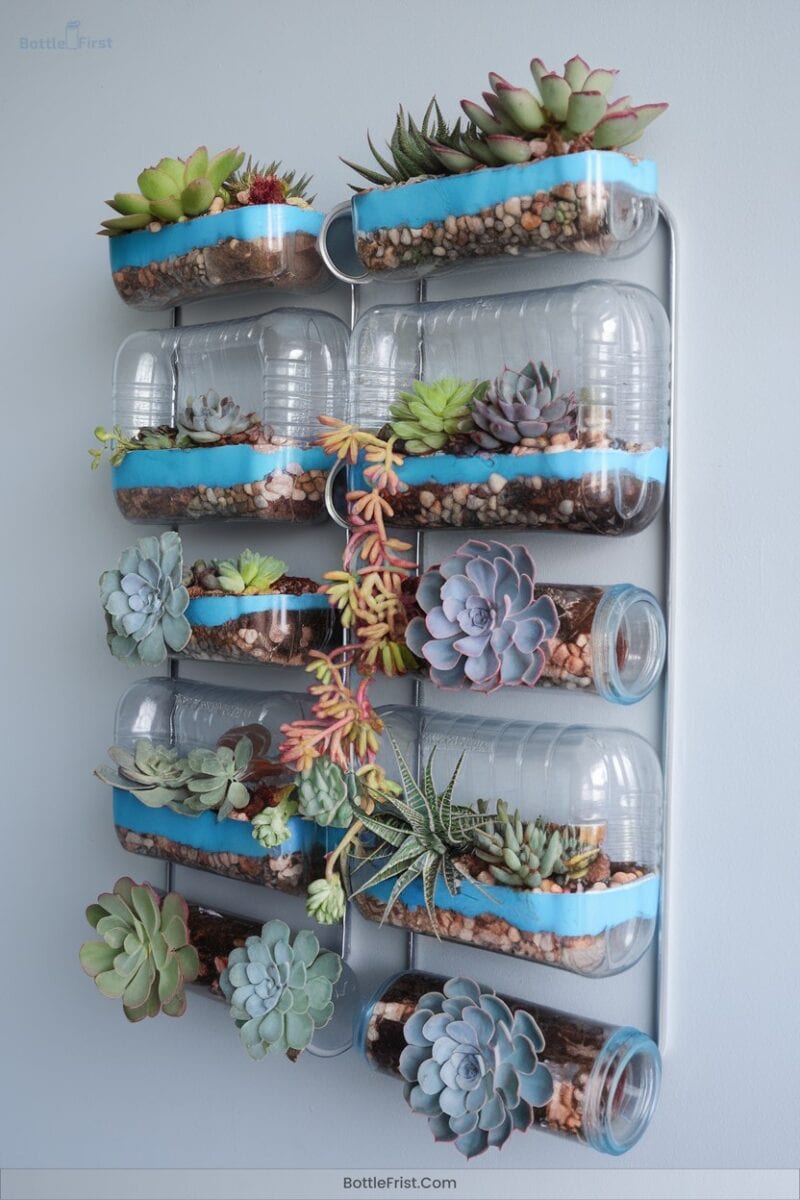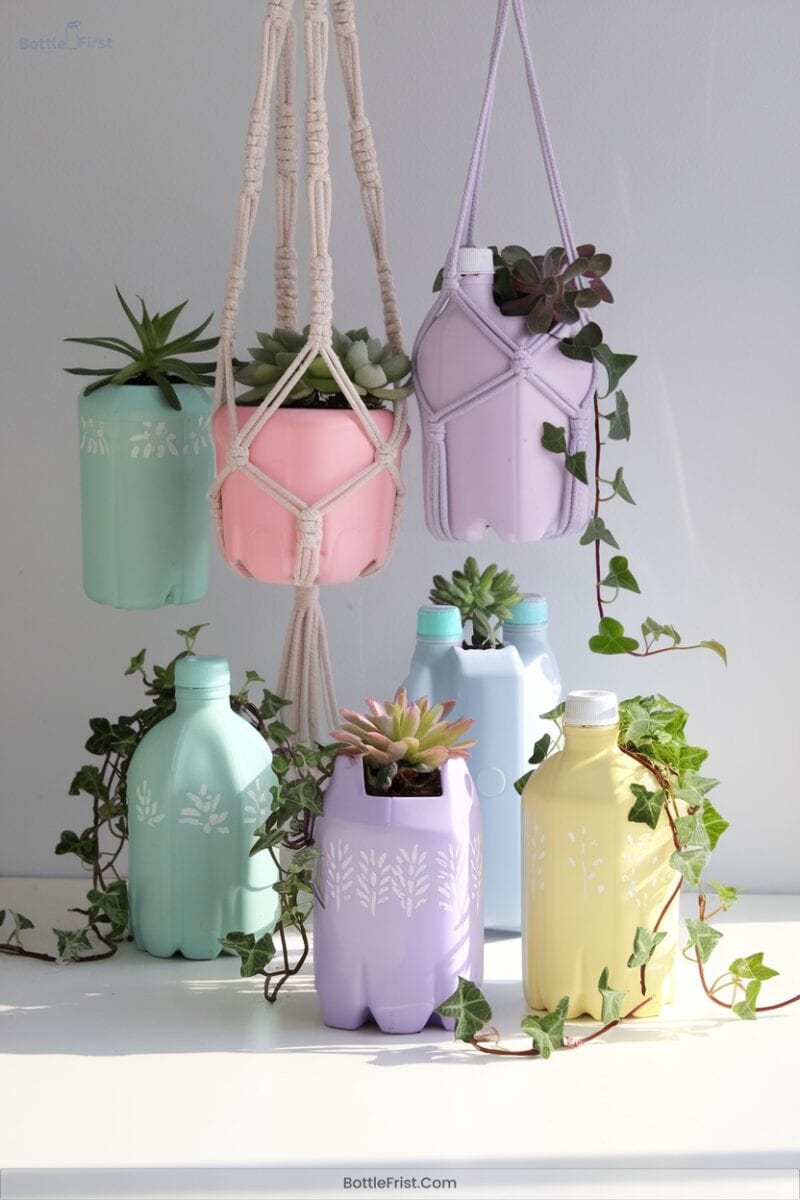10 DIY Plastic Bottle Plant Crafts for Your Indoor Garden
Transform discarded plastic bottles into innovative indoor planters with these creative DIYs. Craft hanging bottle planters with HDPE bottles and sturdy twine. Try self-watering designs with cotton wicks to keep your plants hydrated.
Build vertical garden walls for a lush green space, or create terrarium bottles using soda bottles and humidity-loving plants. Immerse yourself in hydroponic systems with nutrient solutions, or experiment with unique herb gardens and mini greenhouses. There’s more to uncover if you explore further.
1. Hanging Bottle Planters
When it comes to creating hanging bottle planters, starting with the right materials is essential for success.
You’ll want to use plastic bottles, preferably 2L or 5L HDPE 2, because they’re durable and heat-resistant, ensuring your planters withstand the elements.
Choose heavy-duty string or twine for hanging; weak materials like sisal won’t cut it.
For crafting, you’ll need effective tools like a drilling tool, awl, or even a pyrograph. These tools help you make precise holes for drainage and string placement, ensuring your planter is both functional and aesthetically pleasing.
Innovate confidently with these essential materials and tools.
2. Self-Watering Bottles
Although simple in concept, self-watering bottles offer an ingenious solution for plant enthusiasts looking to maintain healthy greenery with minimal effort.
Start by choosing plastic bottles and cutting them to create separate compartments for water and plants. Use a cotton wick threaded through a drilled cap hole to enable capillary action, drawing water from the reservoir to your plant’s roots.
Verify the wick is fully saturated before planting to maintain consistent moisture. Monitor water levels regularly and adjust hole sizes for ideal drainage.
This method not only conserves water but also allows you to observe root development through clear bottles.
3. Vertical Garden Walls
After mastering self-watering bottles, you can elevate your gardening skills with vertical garden walls, a creative way to maximize space and bring greenery to urban environments.
Start by using durable HDPE bottles, cutting them vertically, and inverting them to form tiers. Secure your setup with metal bars or wooden sticks, ensuring stability.
Add a drip irrigation system by drilling drainage holes in the bottle bases to nourish lower plants. Protect roots with white paint on interior necks.
Customize with planter openings for herbs or flowers, and mount on walls or trellises. Reinforce frames and manage weight for a thriving garden.
4. Terrarium Bottles
Transforming recycled plastic bottles into terrariums is an inventive way to bring a slice of nature indoors while promoting sustainable practices.
Bringing nature indoors with recycled bottle terrariums promotes sustainability and creativity.
Start with a cleaned 2L soda bottle, cutting it horizontally to form a container. Layer pebbles, fine sand, and activated charcoal to prevent mold, then add nutrient-rich soil.
Choose humidity-loving plants like Peperomia or succulents, inserting them gently. Enhance aesthetics with crystals or mini figurines.
For airflow, drill cap holes or leave the top open. Guarantee indirect sunlight and wipe condensation; water every 4–6 months for closed terrariums.
Maintain with regular pruning and watch your creation thrive.
5. Herb Garden Towers
Creating an herb garden tower with plastic bottles is a clever way to maximize your vertical growing space and add a sustainable touch to your home gardening.
Start with 2-liter plastic bottles, cutting off the bottoms to form plant chambers. Attach these using strings or wires to a sturdy support structure, ensuring you’ve marked positions precisely.
Remember, drainage holes in each bottle’s bottom are essential to prevent waterlogging. Fill the chambers with garden soil or potting mix.
Consider using alternative containers like single-serve bottles or milk jugs for a creative twist.
With these towers, you can cultivate a vibrant, space-efficient herb garden.
6. Bottle Cacti Displays
For material adaptations:
- Bottle Sourcing: Opt for 1.5L PET bottles or small laundry detergent containers.
- Base Stabilization: Use rocks or cut lids for stability.
- Color Manipulation: Paint interiors green for a natural look.
With these tips, your indoor garden will thrive with innovation!
7. Hydroponic Bottle Systems
Imagine transforming everyday plastic bottles into efficient hydroponic systems, creating a sustainable and space-saving solution for growing plants indoors.
Start by cutting a 1L or 2L bottle two-thirds from the base, forming a reservoir and planting area. Drill a hole in the cap, then thread a cotton, twine, or fabric wick through it to facilitate capillary action.
Fill the upper section with coco coir, perlite, or a soilless mix to support roots. Add a nutrient solution in the reservoir for essential plant growth.
This innovative wick system guarantees plants receive constant moisture and nutrients, fostering thriving indoor gardens effortlessly.
8. Succulent Bottle Gardens
While many overlook the potential of discarded bottles, transforming them into succulent gardens brings a touch of ingenuity and charm to your home. Crafting these unique displays requires a few essential materials.
Start with these steps:
- Bottle Preparation: Choose between glass or plastic. Use a glass cutter for wine bottles or a craft knife for plastic. Guarantee drainage holes are ready.
- Plant Selection: Opt for 3–5 small succulents, like Echeveria or Hen-and-Chicks, to fit your space.
- Assembly: Layer with well-draining soil, position succulents strategically, and top with pebbles for elegance and soil stability.
Transform your space creatively!
9. Miniature Greenhouses
Constructing miniature greenhouses from plastic bottles allows you to cultivate a controlled environment for your plants, even if space is limited.
Start with clear 2-liter plastic bottles for the best light transmission. Remove labels and residues thoroughly. Use an X-acto knife or scissors to cut the bottle, creating an accessible opening.
Cover this opening with plastic wrap or netting, using rubber bands or sticky tape to secure it. This retains moisture and facilitates airflow.
Don’t forget to make drainage holes at the bottom to prevent waterlogging.
These innovative mini-greenhouses let you nurture delicate seedlings or herbs indoors efficiently.
10. Recycled Bottle Planters
Transforming plastic bottles into creative planters is a practical and eco-friendly way to repurpose everyday items while nurturing your green thumb. Here’s how you can get started:
Transform plastic bottles into eco-friendly planters and cultivate your green thumb with ease.
- Materials Needed: Gather plastic bottles, potting soil, and a utility knife. Add decorative elements like paint for personalization.
- Construction Techniques: Cut the bottle, invert the top, and add a wick for water management. Ascertain drainage holes are in place.
- Suitable Plants: Herbs, succulents, and beans thrive in these setups, making them ideal for your indoor garden.
With these steps, you’ll craft planters that not only look great but function efficiently.
Frequently Asked Questions
How Do I Clean and Prepare Plastic Bottles for Planting?
You’ll clean bottles by scrubbing with soap, hot water, and removing labels carefully. Rinse thoroughly, air-dry upside down, and check for cracks. These steps prevent leaks and guarantee your innovative planting projects start on the right foot.
What Types of Plants Are Suitable for Plastic Bottle Crafts?
Think of herbs as little green wizards transforming your space. You can grow basil, mint, or thyme in plastic bottles. They flourish with minimal soil, turning your indoor garden into a vibrant, aromatic haven of creativity.
Can I Paint or Decorate the Bottles Without Harming Plants?
You can safely paint or decorate bottles by using plastic-specific paints, ensuring thorough curing before planting. Stick to exterior-only decoration, avoid direct soil contact with paint, and choose UV-resistant materials for long-lasting, plant-friendly designs.
How Do I Ensure Proper Drainage in Bottle Planters?
You’re transforming bottles into plant sanctuaries! Guarantee drainage by creating 3-4 evenly spaced holes with a drill or heated nail. This prevents waterlogging and turns your planters into a magical haven for thriving roots.
What Tools Are Needed for Cutting and Assembling Bottle Crafts?
You’ll need an Exacto knife for precision, a utility knife for sectioning, and scissors for clean edges. Use super glue for assembly, disposable blades for consistent strips, and dry-erase markers for accurate cuts. Innovate confidently!
Conclusion
You’ve got a world of creative possibilities with plastic bottle plant crafts, transforming your indoor garden into a vibrant oasis. Did you know that recycling just one ton of plastic bottles can save 3.8 barrels of oil?
By using these bottles for projects like hanging planters or self-watering systems, you’re not only beautifying your space but also contributing to environmental conservation. Immerse yourself in these DIY ideas and make a meaningful impact on your home and the planet!
